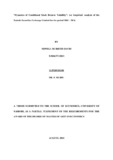| dc.description.abstract | This study analyzed the volatility in conditional stock returns at Nairobi Securities Exchange
for the period 2ndJanuary 2001 to 31st March 2014. The study adopted a purely econometric
approach majorly using the ARCH – family econometric models with a blend of both the
symmetric and the asymmetric models in attempt to ensure robustness of the results.
The study focused on the main aspects of daily returns with special attention on volatility
clustering, leptokurtosis, long memory, market risk premia and the leverage effect. In
addition, the study captured the day of the week as well as the effects of changes in policies
and regulations on the daily stock returns at the NSE. The results are as follows: returns are
predictable thus rejecting the weak form efficiency. On volatility, market volatility effects on
stock returns are short lived and decay at a short interval in addition to them being not
explosive. Market premium is priced at NSE hence acceptance of time – varying risk
premium theory. For the day of the week, Tuesdays and Thursdays post negative significant
returns. The implication is that announcements for sale of government securities mainly
treasury bills on Thursdays and their actual sale on Tuesdays adversely affect equity market.
The ARCH – LM tests indicate that daily stock returns at NSE are generated by a stochastic
rather than a chaotic process. Introduction of the new regulations on foreign investors with a
25% minimum reserve of the issued share capital going to local investors (in 2002),
introduction of live trading, cross listing in Uganda and Tanzania stock exchange (in 2006)
and change in equity settlement cycle from T+4 to T+3 (in 2011) significantly reduce
volatility clustering, impact of bad news in market, volatility shocks and their persistence for
the entire sample with the onset of US tapering increasing the daily mean returns significantly
while reducing conditional volatility. | en_US |

